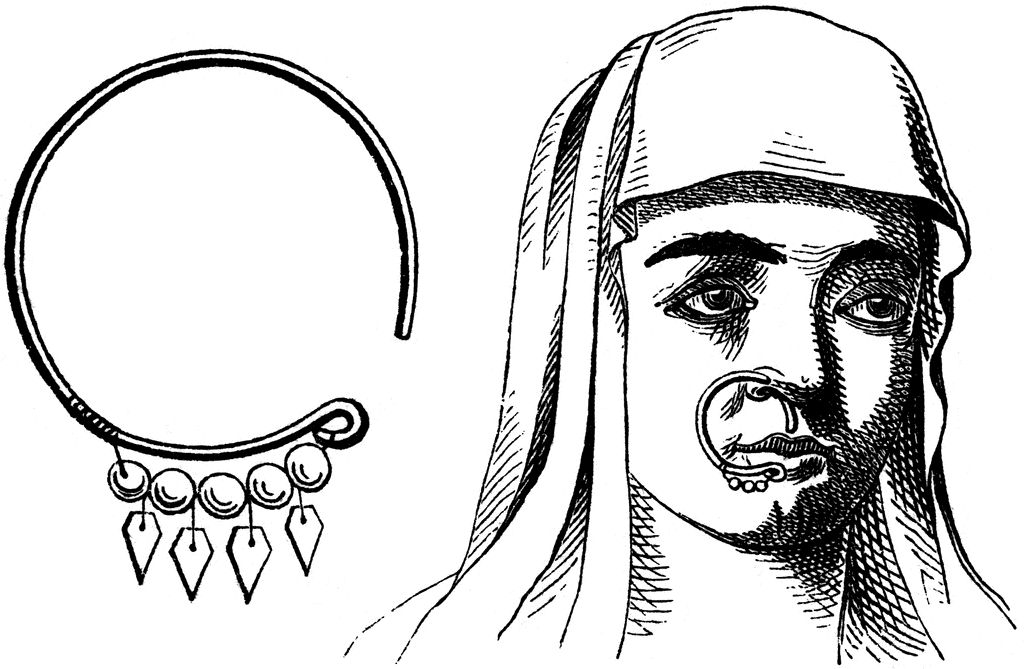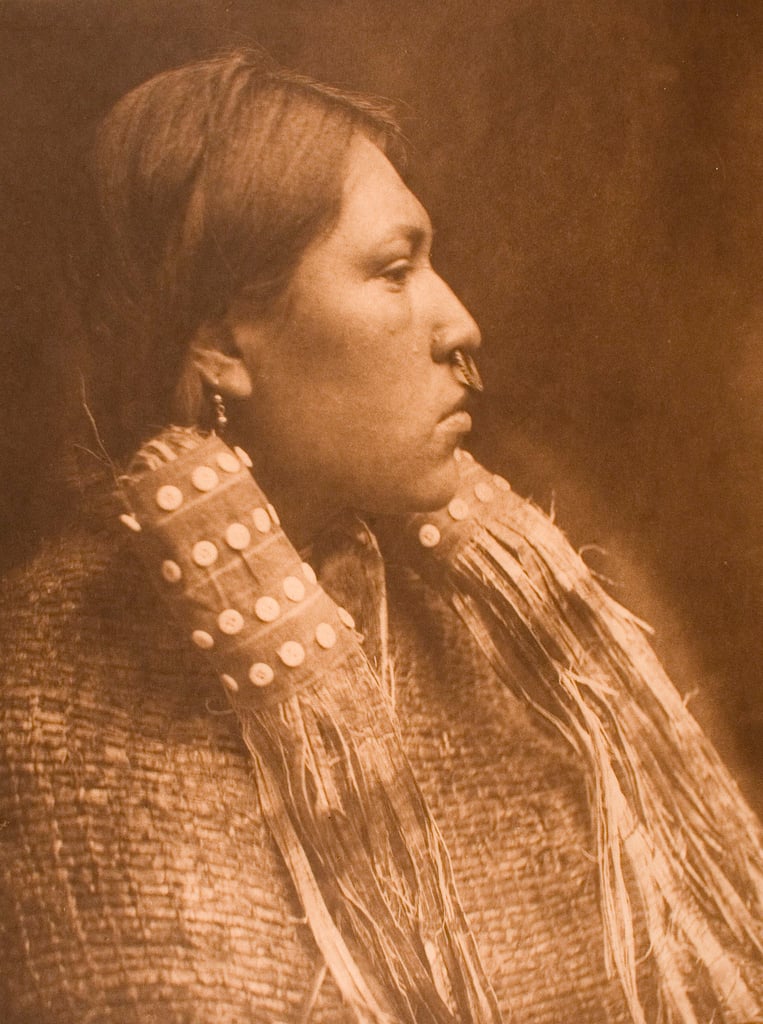Nose Rings: Meanings, History & Significance
 Nose piercings like nose rings and septum piercings have become increasingly trendy in Western society, but this practice is far from new. Various nose piercing traditions around the world date back centuries.
Nose piercings like nose rings and septum piercings have become increasingly trendy in Western society, but this practice is far from new. Various nose piercing traditions around the world date back centuries.
As Western societal norms surrounding what consistutes “professionalism” and general beauty standards have become increasingly more flexible, the popularity of formerly taboo body modifications — like tattoos and piercings beyond ear lobes — has grown exponentially.
Many folks today simply opt for nose piercings as a style choice, but the tradition holds significance and spiritual meanings for many others.
So, what is the significance of wearing a nose ring? We’ll be answering that today as we go through the origins, meanings, and history of nose rings.
First, let’s go over some nose piercing basics.

Types of Nose Piercings
Today, the most common type of nose piercing is a nostril piercing on a single side. Those opting for a more subtle look may choose a nose stud, while others may opt for a nose ring hoop. Most piercers will use a twist nose stud — which is sort of in between a stud and a ring — for the initial piercing to aid the healing process.
However, septum piercings (through the center like a bull ring) have become increasingly popular. An initial septum piercing usually uses a horseshoe-shaped nose ring.
Besides the placement, you can also customize the jewelry of nose piercings. For instance, the best metals for nose rings partly depends on how long you want the jewelry to last. But it can also depend on your complexion; warm-toned skin may be better-suited to gold nose rings while cool-toned complexions are better complemented by sterling silver nose rings.
For a full list of the types of nose piercings and what they look like, check out our Ultimate Guide to Nose Ring Piercings.
With the basics established, it’s time to get into the history behind nose rings.
 Image credit: National Library of Australia
Image credit: National Library of Australia
When Did Nose Rings Start?
The oldest known record of nostril piercings comes from the Middle East and dates back roughly 4,000 to 5,000 years ago. Around 2,000 years after that, nose piercings were written about in the Biblical Old Testament, called Shanf in Hebrew which may translate to “nose ring.”
The origin of septum piercings goes back even further — the oldest known bone jewelry, likely worn as a septum piercing, was a crafted artifact found in Australia that dates back to around 44,000 BC.
In fact, the oldest known mummified body, 5,200-year-old Ötzi the Iceman, also has the oldest piercing ever found on a human (though it’s an ear piercing). To save you the math, Ötzi lived somewhere between 3,350 to 3,110 BC. The oldest known earrings are a little younger, found in a grave dating back to 2,500 BC.
All that said, certain cultures throughout history have a stronger association with nose piercing traditions.

Image credit: Florida Center for Instructional Technology
What Cultures Use Nose Rings?
Nose piercings and nose rings aren’t exclusive to one culture. Arguably, Indian or Hindu culture is most commonly associated with the practice. Between 700 BC to 400 AD (the Classical Era), nose rings were most commonly worn by people native to SWANA countries (Southwest Asian and North African). These countries include:
India
Pakistan
Sri Lanka
Bangladesh
Nepal
Iran
North African communities like the Beja and Berber groups also commonly wear nose piercings. During the 1500s, the Mughal Empire of Central Asia, specifically the emperor Babur, reportedly brought the nose piercing tradition to India and other south Asian countries.
Nose rings also have cultural prevalence in Poland and among indigenous tribes like Native Americans, indigenous Australians, and the Ilocano in the Philippines.
Each culture may have their own reasons for wearing nose rings.

Cultural Reasons for Nose Rings
In SWANA countries, particularly India, women and young girls traditionally wear nose piercings (that they call nath or Nathori) for various reasons. These can range from rebelling against Western cultural expansion, indicating one’s marital status, or honoring a goddess, just to name a few.
Also, many African and Middle Eastern groups use nose rings of different sizes and quality to indicate the wealth or class of one’s family. Traditionally, husbands will give their brides nose rings, often elaborate chains falling decoratively across a women’s cheek and attaching to her ear.
Getting one’s nose pierced is part of the rite-of-passage for boys in the Central Australian Arunta tribe through a ritual called the “nose bone ceremony.” Similarly, many Native American boys get their nose pierced as a rite-of-passage after successfully returning from a vision quest.
Additionally, a common reason for nose piercings — usually adorned with bone jewelry — in many indigenous Australian tribes is for the beauty-related purpose of flattening the nose.
In contrast, large-gauge nostril piercings were apparently worn by women of the Tibetan-originated Apa Tani tribe in India to look less desirable to men of nearby tribes.
Various indigenous tribes in America, Australia, South America, and India associate nose rings with warrior culture. The traditional bone septum piercing in Australia made one look more intimidating, for example.
In South American tribes, nose rings could signify one’s ranking or victory in battle. This follows from ancient Mayan ceremonies featuring nose piercing as a status symbol. Ancient Mayans similarly used nose rings as indicators of wealth and military or social status.
Of course, many nose ring traditions have religious purposes. So, what does a nose ring mean spiritually?
Religious Meanings of Nose Rings
Like many types of jewelry, nose rings and septum piercings have various spiritual or religious meanings depending on the culture and religion.
Let’s start with Hinduism.
 Image credit: Prakhar Amba from Grenoble, France | Creative Commons Attribution 2.0 Generic license
Image credit: Prakhar Amba from Grenoble, France | Creative Commons Attribution 2.0 Generic license
Nose Ring Meanings in Hindu
Hinduism is the third-largest religion worldwide and originates from India. Roughly 60 percent of South Asians practice Hinduism, according to Pew Research Center.
Part of some branches of Hinduism is a group of 16 ceremonies called the Shodasha Samskaras that indicate different rites-of-passage throughout one’s life. The eighth one is the Karnavedha Samskara, where six- or seven-month-old babies have their ears pierced to help develop strong decision-making and intellect.
There are a few nose ring meanings and purposes in Hinduism. While only Indian women wore them historically, Indian men have started to wear nose rings in recent times as well.
In Hindu traditions, what does a nose ring on a woman mean? Nose rings for Hindu women may signify:
Marriage: Wearing a nose ring is often an external indicator that a woman is married, though unmarried Hindu women may wear nose rings, too.
Womanhood: Younger Hindu women may wear nose rings as a coming-of-age ritual.
Goddess Worship: Brides often wear nose rings to honor Pavarti, the Hindu goddess of marriage, and attract her blessings. Parvati, along with other Hindu goddesses like Lakshmi and Saraswati, are also traditionally depicted wearing nose rings.
Health Benefits: According to some Hindu beliefs, nose rings help women be more fertile, have less menstrual pain, and have easier childbirths.
The purported health benefits mentioned above tie to Ayurvedic medicine and the belief that the nose connects to reproductive organs. Different communities traditionally pierce different sides of the nose for these benefits — Northern Indians traditionally have nose piercings on the left, while Southern Indians usually have them on the right.
Most often, Hindu women will have nose rings on the left side, though some will pierce both sides.
In some Hindu communities, women will remove their nose ring after their husband dies.
 Image credit: Museum of Photographic Arts
Image credit: Museum of Photographic Arts
Nose Piercings in Indigenous Cultures
Among various indigenous tribes, the meaning of septum nose rings are culturally and spiritually significant.
In North American tribes, besides being a rite-of-passage, other members like Shawnee leaders (including the famous Tecumseh) wore nose rings to indicate their leadership role. The name of one tribe native to Washington, the Nez Perce, actually derives from the French term for “nose-pierced.”
Down in Central and South America, ancient Aztecs, Incas, and Mayans decorated their septum rings for religious purposes. They often used gold and jade for their rareness and strength to symbolize how important their religious rituals were, as only the best materials should be worn to honor their gods. The Guna (or Cuna) tribe of Panama continues this tradition today.
Member of the Asmat tribe of Irian Jaya (now called West Papua or New Guinea) wears big, thick bone septum rings called Otsj traditionally made from boar tusks, pig leg bones, or the bones of defeated enemies.
 Image credit: Photo by Janko Ferlič on Unsplash
Image credit: Photo by Janko Ferlič on Unsplash
Nose Rings in Western Society
Nose rings didn’t reach Western society until more recently in history, spread by sailors coming back from places where nose rings were culturally established.
The first major introduction of nose rings into Western culture came in 1913, when influential French singer Émilie Marie Bouchaud (stage name Polaire) wore one during her American tour. Ethel Granger, beauty icon and smallest-waist record-holder, further popularized nose piercings along with other body modifications.
However, the modern trend of nose rings in Western society really took off in the 1960s as so-called “hippies” went to India for spiritual enlightenment and brought the trend back home. By the 1970s, folks in the punk and goth subcultures adopted nose rings as well.
Music videos of the 1990s, along with other appearances of celebrities wearing nose rings, helped spread the trend even further into mainstream culture.
But what did nose rings represent among these groups?
 Image credit: Photo by Gursimrat Ganda on Unsplash
Image credit: Photo by Gursimrat Ganda on Unsplash
What Do Nose Rings Symbolize Today?
Since the adoption of nose rings among the hippie, goth, and punk movements of the late 1900s, nose rings have come to symbolize rebellion, counterculturalism, and non-conformity in Western society. Septum piercings in particular are commonly seen in the rebellious anarchist or punk subcultures.
Besides subversion or rebellion, nose rings in Western society today are often simply a fashion accessory. The style may be chosen for an edgy look or simply because you like it.
Ironically, many South Asians who immigrated (or whose families immigrated) west wear nose rings to represent defiance against Western beauty standards and acknowledge their heritage in the face of pressures to conform.
According to a 2021 Wall Street Journal article, “Gen X and older millennial women are increasingly splurging on multiple earlobe and cartilage piercings. Some are awakening long-dormant wild streaks. Others are reasserting their identities.”
What Type of Nose Ring is Best?
As you can see, the reasons and traditions of nose rings vastly vary. Whether you wear nose rings for religious, cultural, or style reasons, their are dozens of unique nose rings out there for every taste or purpose. If you ask us, the best nose ring for you is the one that makes you feel like your best self!
Ready to shop? Browse our collection of jewelry and accessories today!
Was this article helpful?
Ross Sedawie
- Written - 22nd Apr 2019
- Edited - 8th Apr 2024










